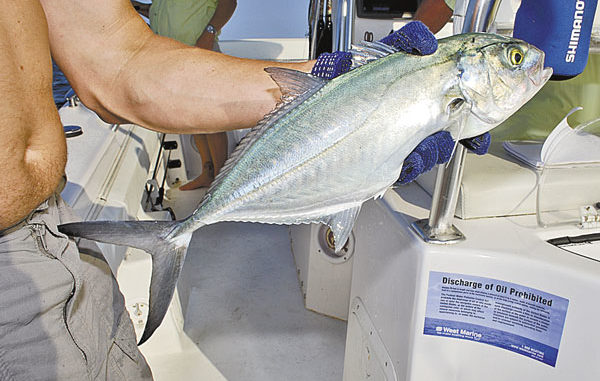
No, I don’t mean those wonderful Louisiana canned red beans. I am talking about the fish, Caranx Crysos, a.k.a. hardtails. Blue runners are a member of the jack family, Carangidae, which includes 28 species in North American Atlantic and Gulf of Mexico waters.It probably gets the nickname “hardtail” from the row of large hard scutes, modified scales, along its lateral line near the tail. Many other jacks, including African pompano, yellow jack, crevalle jack, horse-eye jack, bar jack, round scad (cigar minnows) and bigeye scad also have these scutes.
It is something of a nondescript fish in a family of fishes that have a lot of identification challenges. It is laterally compressed (biologist talk for flattened from side-to-side) and football-shaped when viewed from the side. In spite of being called a blue runner, it isn’t particularly blue, but rather more bluish green to olive green, shading to silvery gray beneath,with yellow tinges. The word “crysos” in its scientific name means “gold” in Greek, and refers to the yellow highlights.
Blue runners are not a particularly long-lived species. The oldest one on record is 11 years old. Blue runners up to 28 inches long and 11 pounds have been recorded, but most are much smaller, typically less than 18 inches long.
In the Gulf of Mexico, this species matures at an average of 9 inches for males and 10 inches for females. They apparently spawn year round with a peak in the northern Gulf between June and August. Females produce from 41,000 to 1.5 million eggs, depending on the size of the fish. Both the eggs and larvae are free-floating and at the mercy of currents. After the larvae develop some swimming ability, they gravitate toward floating objects or sargassum weed and even slow-moving jellyfish.
Lots of Gulf fishermen pursue blue runners, but not typically for table fare. Rather, it is considered one of the premier baitfish for large predatory fish such as king mackerel, amberjack and billfish. (It is indeed eaten in other countries and sold in large amounts fresh, dried or smoked.) Part of its popularity with anglers is certainly due to its availability. Schools estimated to be over 10,000 fish have been documented, although most schools are much smaller.
In most of its range, adult blue runners are found over reefs in offshore waters, although juveniles are often found in shallower waters, even inshore. Seven dark vertical bands can often be seen on the bodies of juvenile blue runners.
But, off the Louisiana coast, blue runners are usually associated with oil- and gas-production platforms. Research has shown that up to 94 percent of the many thousands of fish around some platforms may be blue runners.
It seems that they are attracted to these platforms by food, but not the plant and animal growths that occur on platform legs and stanchions. Rather, they eat zooplankton, a term that includes tiny free-floating animals and the larvae of bigger marine life, including those of the biggest of fishes.
Blue runners throughout their range in the mid-latitudes of both sides of the Atlantic, including the Mediterranean Sea, have been documented to feed heavily on zooplankton until about 12 inches long, and then shift their diet increasingly to fish, with some shrimp and crabs thrown in as they grow larger. Here in the northern Gulf, blue runners have been shown to continue their planktivorous ways all their lives.
An interesting sidebar to their food habits is that in blue waters offshore, blue runners, with their fast swimming ability, will hang with spinner dolphins to feed on food scraps and on small fish disoriented by the dolphins. They also eat — ugh — the dolphins’ feces.
Meanwhile, back at the Gulf of Mexico platforms, blue runners have been shown to feed on zooplankton all day, but really binge before daylight, between 3 a.m. and 7 a.m. The theory is that lights on the platforms allow the sight-feeding fish to see well enough to feed in darkness.
Since the zooplankton in their diets is likely carried by currents to the platforms rather than produced by the platforms, it seems logical that platforms don’t “produce” these fish. However, platforms may play an important role. Research has shown that ocean current speeds can be reduced by 20 percent or more immediately down-current from a platform, and that the platform legs and casings can break the current enough to form eddies behind them.
The reduced currents and eddies can, to a degree, concentrate whatever the currents carry, including zooplankton. Also, some zooplankters that have weak swimming ability move toward lights, which would tend to concentrate them around lighted platforms at night.
These factors may provide blue runners with increased concentrations of food and the ability to feed around the clock. Such conditions may explain how the large numbers of blue runners and their predators can be sustained in waters around platforms.
Jerald Horst is the author of four books on fish and seafood, including the acclaimed, Trout Masters: How Louisiana’s Best Anglers Catch the Lunkers. His latest book, co-authored with his wife Glenda, is The Louisiana Seafood Bible: Crawfish.


